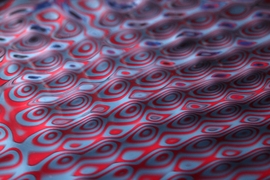The central mystery of quantum mechanics is that small chunks of matter sometimes seem to behave like particles, sometimes like waves. For most of the past century, the prevailing explanation of this conundrum has been what’s called the “Copenhagen interpretation” — which holds that, in some sense, a single particle really is a wave, smeared out across the universe, that collapses into a determinate location only when observed.
But some founders of quantum physics — notably Louis de Broglie — championed an alternative interpretation, known as “pilot-wave theory,” which posits that quantum particles are borne along on some type of wave. According to pilot-wave theory, the particles have definite trajectories, but because of the pilot wave’s influence, they still exhibit wavelike statistics.
John Bush, a professor of applied mathematics at MIT, believes that pilot-wave theory deserves a second look. That’s because Yves Couder, Emmanuel Fort, and colleagues at the University of Paris Diderot have recently discovered a macroscopic pilot-wave system whose statistical behavior, in certain circumstances, recalls that of quantum systems.
Couder and Fort’s system consists of a bath of fluid vibrating at a rate just below the threshold at which waves would start to form on its surface. A droplet of the same fluid is released above the bath; where it strikes the surface, it causes waves to radiate outward. The droplet then begins moving across the bath, propelled by the very waves it creates.
“This system is undoubtedly quantitatively different from quantum mechanics,” Bush says. “It’s also qualitatively different: There are some features of quantum mechanics that we can’t capture, some features of this system that we know aren’t present in quantum mechanics. But are they philosophically distinct?”
Tracking trajectories
Bush believes that the Copenhagen interpretation sidesteps the technical challenge of calculating particles’ trajectories by denying that they exist. “The key question is whether a real quantum dynamics, of the general form suggested by de Broglie and the walking drops, might underlie quantum statistics,” he says. “While undoubtedly complex, it would replace the philosophical vagaries of quantum mechanics with a concrete dynamical theory.”
Last year, Bush and one of his students — Jan Molacek, now at the Max Planck Institute for Dynamics and Self-Organization — did for their system what the quantum pioneers couldn’t do for theirs: They derived an equation relating the dynamics of the pilot waves to the particles’ trajectories.
In their work, Bush and Molacek had two advantages over the quantum pioneers, Bush says. First, in the fluidic system, both the bouncing droplet and its guiding wave are plainly visible. If the droplet passes through a slit in a barrier — as it does in the re-creation of a canonical quantum experiment — the researchers can accurately determine its location. The only way to perform a measurement on an atomic-scale particle is to strike it with another particle, which changes its velocity.
The second advantage is the relatively recent development of chaos theory. Pioneered by MIT’s Edward Lorenz in the 1960s, chaos theory holds that many macroscopic physical systems are so sensitive to initial conditions that, even though they can be described by a deterministic theory, they evolve in unpredictable ways. A weather-system model, for instance, might yield entirely different results if the wind speed at a particular location at a particular time is 10.01 mph or 10.02 mph.
The fluidic pilot-wave system is also chaotic. It’s impossible to measure a bouncing droplet’s position accurately enough to predict its trajectory very far into the future. But in a recent series of papers, Bush, MIT professor of applied mathematics Ruben Rosales, and graduate students Anand Oza and Dan Harris applied their pilot-wave theory to show how chaotic pilot-wave dynamics leads to the quantumlike statistics observed in their experiments.
What’s real?
In a review article appearing in the Annual Review of Fluid Mechanics, Bush explores the connection between Couder’s fluidic system and the quantum pilot-wave theories proposed by de Broglie and others.
The Copenhagen interpretation is essentially the assertion that in the quantum realm, there is no description deeper than the statistical one. When a measurement is made on a quantum particle, and the wave form collapses, the determinate state that the particle assumes is totally random. According to the Copenhagen interpretation, the statistics don’t just describe the reality; they are the reality.
But despite the ascendancy of the Copenhagen interpretation, the intuition that physical objects, no matter how small, can be in only one location at a time has been difficult for physicists to shake. Albert Einstein, who famously doubted that God plays dice with the universe, worked for a time on what he called a “ghost wave” theory of quantum mechanics, thought to be an elaboration of de Broglie’s theory. In his 1976 Nobel Prize lecture, Murray Gell-Mann declared that Niels Bohr, the chief exponent of the Copenhagen interpretation, “brainwashed an entire generation of physicists into believing that the problem had been solved.” John Bell, the Irish physicist whose famous theorem is often mistakenly taken to repudiate all “hidden-variable” accounts of quantum mechanics, was, in fact, himself a proponent of pilot-wave theory. “It is a great mystery to me that it was so soundly ignored,” he said.
Then there’s David Griffiths, a physicist whose “Introduction to Quantum Mechanics” is standard in the field. In that book’s afterword, Griffiths says that the Copenhagen interpretation “has stood the test of time and emerged unscathed from every experimental challenge.” Nonetheless, he concludes, “It is entirely possible that future generations will look back, from the vantage point of a more sophisticated theory, and wonder how we could have been so gullible.”
“The work of Yves Couder and the related work of John Bush … provides the possibility of understanding previously incomprehensible quantum phenomena, involving 'wave-particle duality,' in purely classical terms,” says Keith Moffatt, a professor emeritus of mathematical physics at Cambridge University. “I think the work is brilliant, one of the most exciting developments in fluid mechanics of the current century.”

















